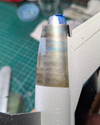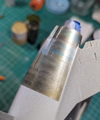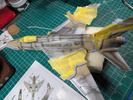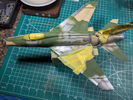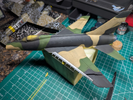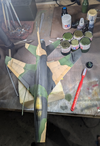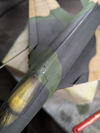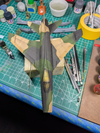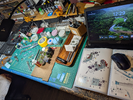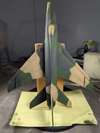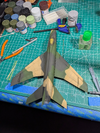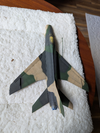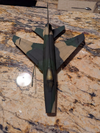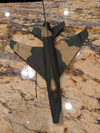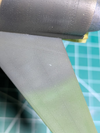you might recall me saying that I found Tamiya acrylics to be fragile. I have a good example from this morning to illustrate what I mean.
Not at all my experience. I have a compound hunting bow, partially painted (to remove the maker's logo) that I've carried through miles of brush of hostile dispositions for years. No scratches. Paint was applied with an airbrush, ~1:1 paint to 90% isopropyl alcohol thinning solvent, no retarder or flow aid. These days, I'd definitely use their retarder, which makes airbrushing their paint much less demanding.
When airbrushing acrylics, a clean surface is a must, even with alcohol solvent paints. Before starting assembly, I wash all the sprues in warm water and detergent, rinse them thoroughly, and use blown air to dry them. That does it for cleaning anything that will be painted on the sprue. Once parts have been assembled, I wipe them down with ethyl alcohol to make sure there is no skin oil or other contaminant before painting. Even my desiccated skin leaves oil on the surface. Tamiya X and XF lines are alcohol soluble, so they are slightly more tolerant of surface contamination, but nowhere near as tolerant as other hydrocarbon solvents.
If I recall correctly, you like to apply the paint in thin coats, and I think I recall you thinning it significantly more than 1:1. Correct me if I'm recalling incorrectly. Building up thinner coats is good technique—but too thin has to be avoided. This is because the paint has to be dense enough on the surface for the individual spray particles to touch, coalesce, and begin polymerization. Too thin a coat results in "dusting," which can be too fine to see even with low power magnification. This results in a weak paint layer, and the only cure is to remove it and try again. Applying more layers over it will not improve the situation.
I always found Tamiya paints more difficult to airbrush than aqueous paints, especially in conditions of varying temperature and humidity, which affect them more than aqueous systems. I find Tamiya retarder really helps regardless of application method, as does having air conditioning and a more controlled environment.
Do you use a primer coat? For decades I used Tamiya XF-19 Sky Gray
as my primer coat. Adhesion was never a problem.
Now, all that said, it is entirely possible that Tamiya has changed their formulation since I last bought a bottle, some time in the 1990s. If that's the case, your best bet is to use a good quality acrylic primer. Once you have a good primer coat on the surface, you can spray paint at "filter" consistency and it will bond to the primer.

